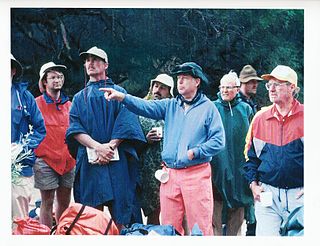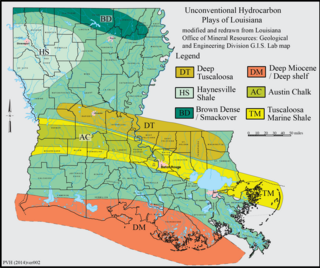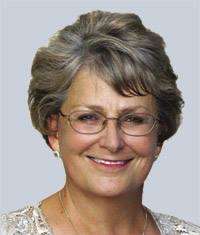
The Salt Creek Oil Field is located in Natrona County, Wyoming. By 1970, more oil had been produced by this field than any other in the Rocky Mountains region and accounted for 20 percent of the total production in Wyoming.

Gilbert Dennison Harris was an American geologist and paleontologist. He was a professor of paleontology and stratigraphic geology at Cornell University and proprietor and editor of two scientific journals, Bulletins of American Paleontology and Palaeontographica Americana. Harris later left Cornell and founded the Paleontological Research Institution, an independent organization dedicated to research and education in the field of paleontology.
Charles Richard Stelck, O.C., Ph.D., F.R.S.C., P.Geol. was a Canadian petroleum geologist, paleontologist, stratigrapher, and university professor. He is known for his pioneering work on unraveling the stratigraphy of the Western Canada Sedimentary Basin, and his inspired use of biostratigraphy as an exploration tool for finding petroleum and natural gas fields.

Fred F. Meissner was an American geologist and engineer who contributed to the fields of geology, geophysics, engineering, petroleum engineering, geochemistry, mineralogy, physics, mining, economic geology, and fishing.

The Cardium Formation is a stratigraphic unit of Late Cretaceous age in the Western Canada Sedimentary Basin. It takes the name from the fossilized heart-shaped cockle shells in the family Cardiidae present. It was first described along the Bow River banks by James Hector in 1895. It is present throughout western Alberta and in northeastern British Columbia, and it is a major source of petroleum and natural gas.

Offshore oil and gas in the United States provides a large portion of the nation’s oil and gas supply. Large oil and gas reservoirs are found under the sea offshore from Louisiana, Texas, California, and Alaska. Environmental concerns have prevented or restricted offshore drilling in some areas, and the issue has been hotly debated at the local and national levels.
In geology, a petroleum play, or simply a play, is a group of oil fields or prospects in the same region that are controlled by the same set of geological circumstances. The term is widely used in the realm of exploitation of hydrocarbon-based resources.
Michel Thomas Halbouty was an American geologist, petroleum engineer, and wildcatter. Credited with discovering more than 50 oil and gas fields, he twice declared bankruptcy, but came back each time to regain wealth. He authored hundreds of technical articles on petroleum geology, and two book-length histories of famous oil fields. Halbouty is often described, including in his New York Times obituary, as “legendary.”
George Martin Lees MC DFC FRS was a British soldier, geologist and leading authority on the geology of the Middle East.
Marvin Dale Mangus (1924–2009) was an American geologist and landscape painter. He was giving the honor of driving a purely symbolic wood stake prior to start of drilling the actual oil well by the Atlantic Richfield Corporation, his employer. The focus of his later art career was glorified role of geologist and other exploration of Alaska. He painted animals and birds and was recognized with awards from The National Park Service

Offshore oil and gas in the Gulf of Mexico is a major source of oil and natural gas in the United States. The western and central Gulf of Mexico, which includes offshore Texas, Louisiana, Mississippi, and Alabama, is one of the major petroleum-producing areas of the United States. Oil production from US federal waters in the Gulf of Mexico reached an all-time annual high of 1.65 million barrels per day in 2017. Oil production is expected to continue the upward trend in 2018 and 2019, based on ten new oil fields which are planned to start production in those years. According to the Energy Information Administration, "Gulf of Mexico federal offshore oil production accounts for 15% of total U.S. crude oil production and federal offshore natural gas production in the Gulf accounts for 5% of total U.S. dry production."

The Brown Dense limestone is an informal name used by petroleum geologists for a layer of rock that lies beneath large parts of southern Arkansas and northwest Louisiana. The Brown Dense is a 300- to 500-foot thick interval within organic-rich, fine-grained carbonate rock that comprise the Lower Member of the Smackover Formation. Within this area, the Lower Smackover Member lies at depths of 8,000 to 10,000 feet beneath the land surface.
Frederick Gardner Clapp (1879–1944) was an American petroleum geologist considered to be the "first American to make a living wholly as a consultant in petroleum geology in 1908."
Caswell Silver was an American geologist and entrepreneur who was President of Sundance Oil Company from 1960 to 1984. In addition to the business of oil and gas exploration, he was active in the American Association of Petroleum Geologists and published original research on petroleum geology. He endowed the Caswell Silver Foundation at the University of New Mexico.

Esther Applin was an American geologist and paleontologist. She completed her undergraduate degree in 1919 from the University of California, Berkeley. Later, she completed a master's degree which was focused on microfossils. She was a leading figure in the use of microfossils to determine the age of rock formation for use in oil exploration in the Gulf of Mexico region. Her job was to examine microfossils collected in drill holes to determine the age of the rock into which the company was drilling. Applin's discoveries were crucial to successful drilling operations across the entire oil industry. Additionally, her contribution to geology and the study of micropaleontology, put women geologists on the map, and was pivotal in earning them respect in the field.

Theron Rhodes Wasson (1887–1970) was a leading American petroleum geologist and engineer, who pioneered the use of geophysical surveys to find oil and gas.

Robbie Rice Gries is an American petroleum geologist who was the first female president (2001–02) of the American Association of Petroleum Geologists (AAPG), president of the Geological Society of America (2018–19), and founder of Priority Oil & Gas LLC. Gries is noted to have made some influential progress for women in this field. In 2017, Gries published the book titled Anomalies—Pioneering Women in Petroleum Geology: 1917-2017. Gries is recognized as an unconventional thinker when approaching geological concepts and applications.

Cindy A. Yeilding is an American geologist from Houston, Texas. Yeilding is Senior Vice President of British Petroleum, America. She was formerly Vice President of exploration technology and assurance, and has held various other positions at BP in oil and gas, exploration of the Gulf of Mexico and geoscience.
John Robert Suman was a geologist, petroleum engineer, and business executive.

Laura Lee Lane Weinzierl was an American petroleum geologist and micropaleontologist who worked in the Texas and Gulf Coast oil fields.











